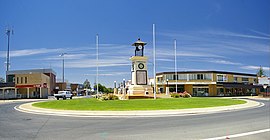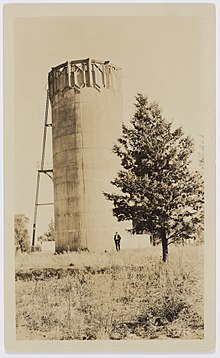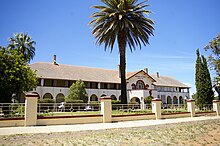Leeton, New South Wales
| Leeton New South Wales | |||||||||
|---|---|---|---|---|---|---|---|---|---|
 Leeton War Memorial | |||||||||
| Coordinates | 34°34′0″S 146°24′0″E / 34.56667°S 146.40000°E | ||||||||
| Population | 6,931 (2016 census)[1] | ||||||||
| Established | 2 April 1913 | ||||||||
| Postcode(s) | 2705 | ||||||||
| Elevation | 138.3 m (454 ft) | ||||||||
| Location |
| ||||||||
| LGA(s) | Leeton Shire | ||||||||
| County | Cooper | ||||||||
| Parish | Willimbong | ||||||||
| State electorate(s) | Murray | ||||||||
| Federal division(s) | Farrer | ||||||||
| |||||||||
Leeton is a town in the Riverina region of southern New South Wales, Australia. It is about 550 km West of Sydney and 450 km North of Melbourne in the Murrumbidgee Irrigation Area,[2] Leeton town population in 2016 was 6,931.[1] Leeton is in one of the most productive farming regions in the state, the town was designed by Walter Burley Griffin and purpose-built for the irrigation schemes announced by the New South Wales government in the early 1900s.[2][3][4] Citrus, rice, cotton, grapes, walnuts and wheat farms can all be found throughout the Leeton Shire. Leeton is called Australia's Rice Capital and as The Heart of SunRice Country, as it is home to the SunRice headquarters.[5][6] Other industry includes the Arnott’s Group (previously Freedom Foods),[7] the Daily Drinks Co., JBS Australia, Webster Limited (walnuts and cotton)[8] and Murrumbidgee Irrigation Limited.
History
[change | change source]Prior to European settlement, the area was inhabited by the Wiradjuri people. The town is named after Charles Alfred Lee, a Government Minister for Public Works in New South Wales from 1904 to 1910.[9]

Historic Hydro Motor Inn
[change | change source]The Hydro Hotel was constructed in 1919. It was built so that the Water Conservation and Irrigation Commission managers had somewhere to stay when in Leeton. It was only licensed to sell alcohol in 1924, after the alcohol prohibition in the Murrumbidgee Irrigation Area was stopped.[10]

Roxy Theatre
[change | change source]The Roxy Community Theatre was built in 1929 and opened in April 1930. [11]

Climate
[change | change source]Leeton has hot dry summers and cool winters.[12]
Notable citizens
[change | change source]Australian poet and writer Henry Lawson lived in Leeton for two years, from 1916 to 1917. Lawson was hired to write about the Murrumbidgee Irrigation Area to attract people to move to the area.[13][14]
References
[change | change source]- ↑ 1.0 1.1 Australian Bureau of Statistics (27 June 2017). "Leeton". 2016 Census QuickStats. Retrieved 24 January 2021.
- ↑ 2.0 2.1 "Leeton, NSW". "Aussie Towns". Retrieved 21 May 2021.
- ↑ "About the Shire". Leeton Shire Council. Archived from the original on 21 February 2008. Retrieved 21 May 2021.
- ↑ "History". Leeton Shire Council. Archived from the original on 8 June 2018. Retrieved 30 May 2018.
- ↑ "Fine Food & Wine". Riverina Regional Tourism. Archived from the original on 19 July 2008. Retrieved 21 May 2021.
- ↑ "The Irrigator" (PDF). Fairfax Media. Riverina Media Group. Archived from the original (PDF) on 6 July 2011. Retrieved 19 August 2008.
- ↑ "Freedom Foods completes sale of Cereal and Snacks to The Arnott's Group, reports 3Q results". Convenience & Impulse Retailing Magazine. Retrieved 21 May 2021.
- ↑ "Webster Annual Report 2017" (PDF). Archived from the original (PDF) on 3 October 2019. Retrieved 21 May 2021.
- ↑ "Place names". The Australian Women's Weekly. National Library of Australia. 13 May 1964. p. 61. Retrieved 21 May 2021.
- ↑ "Hydro Hotel - History". thehydro.com.au. Archived from the original on 21 May 2021. Retrieved 21 May 2021.
- ↑ "Roxy Theatre". thehydro.com.au. Retrieved 21 May 2021.
- ↑ "Climate zone map: New South Wales and Australian Capital Territory". Australian Building Codes Board. Retrieved 21 May 2021.
- ↑ "Images of Henry Lawson". University of Sydney Library. 26 May 2011. Archived from the original on 16 June 2011. Retrieved 5 June 2011.
- ↑ "Henry Lawson". Leeton Shire Council. Retrieved 21 May 2021.
Other websites
[change | change source]- Leeton Shire Council – council website
- Leeton Visitors Information Centre
